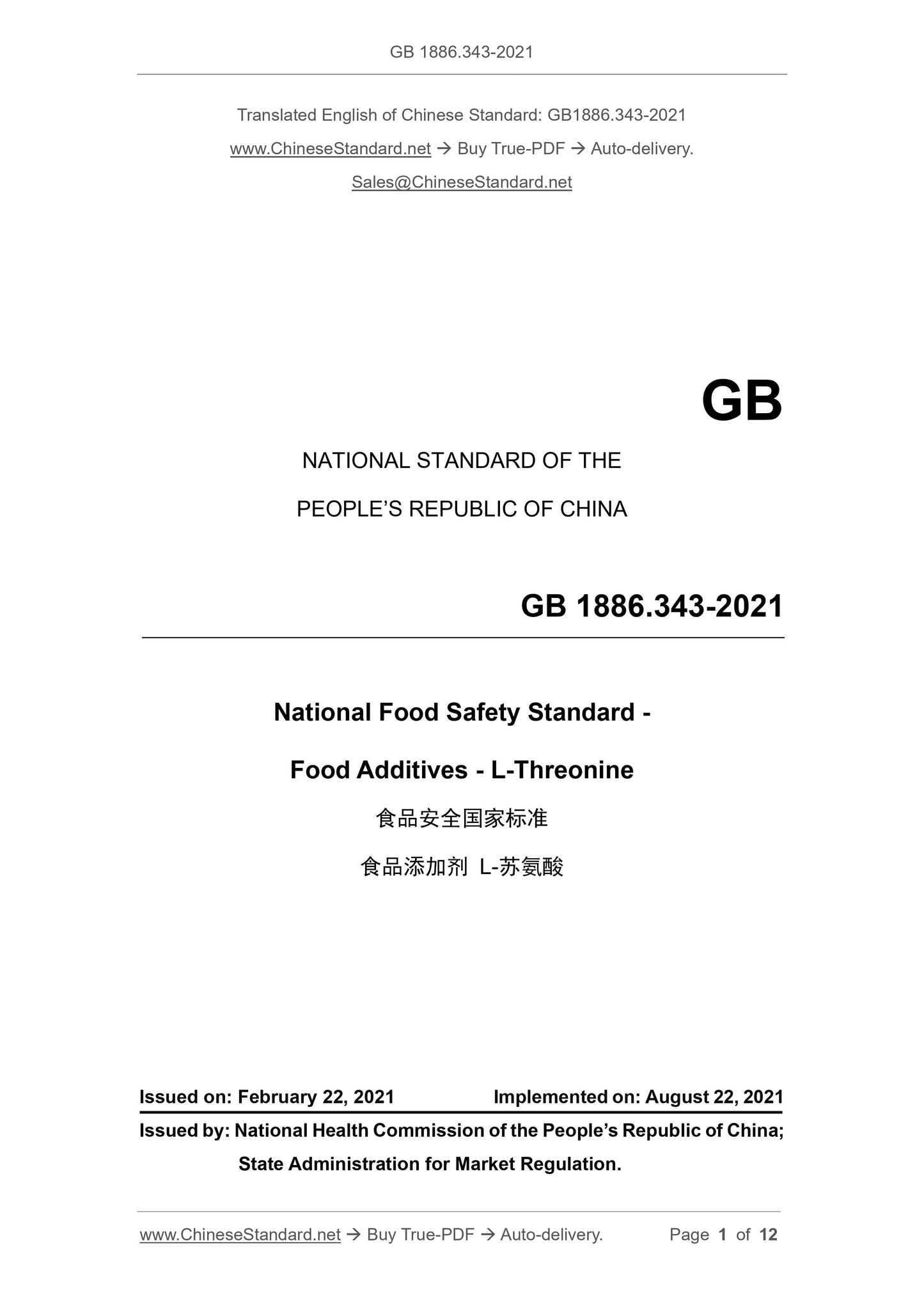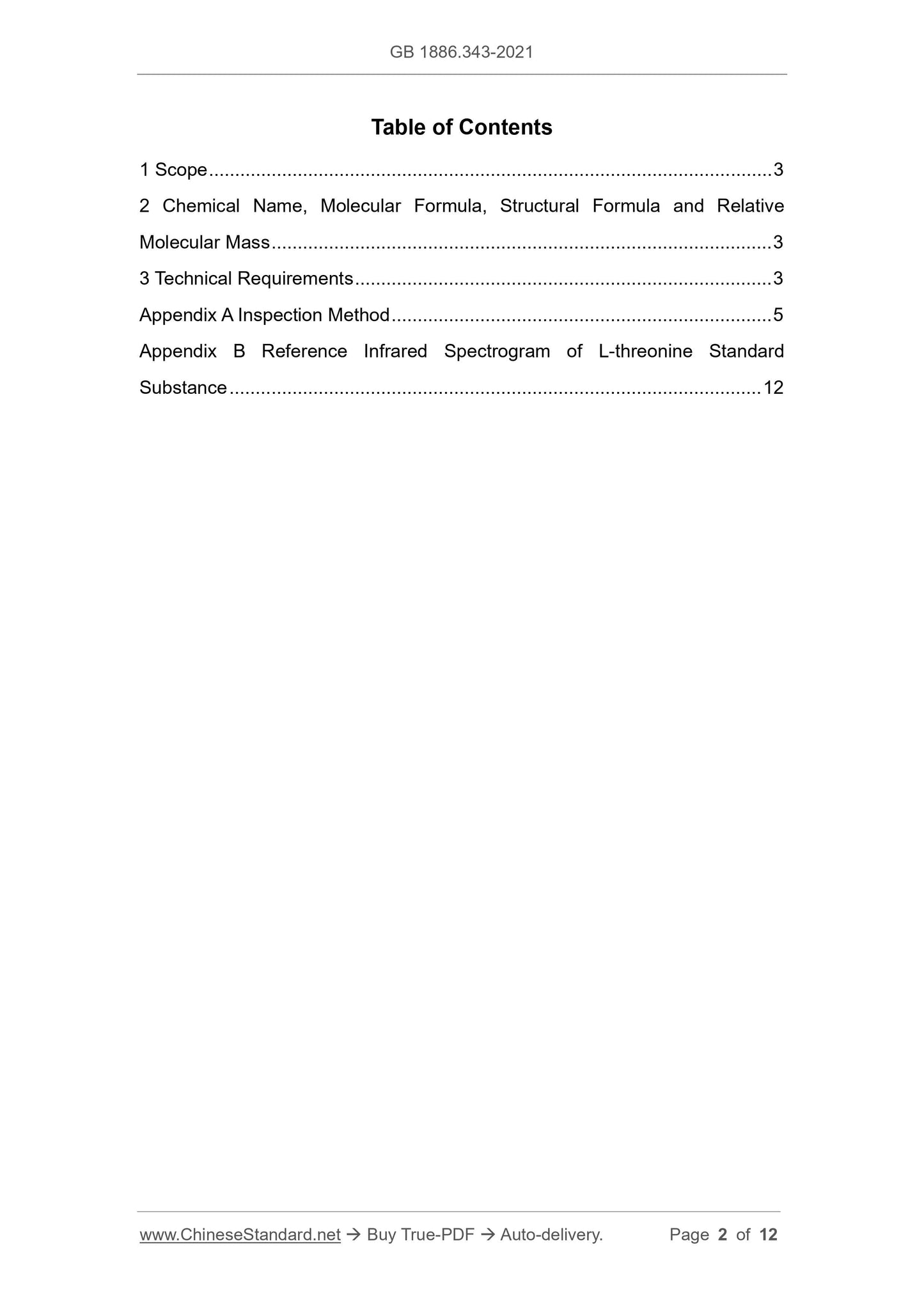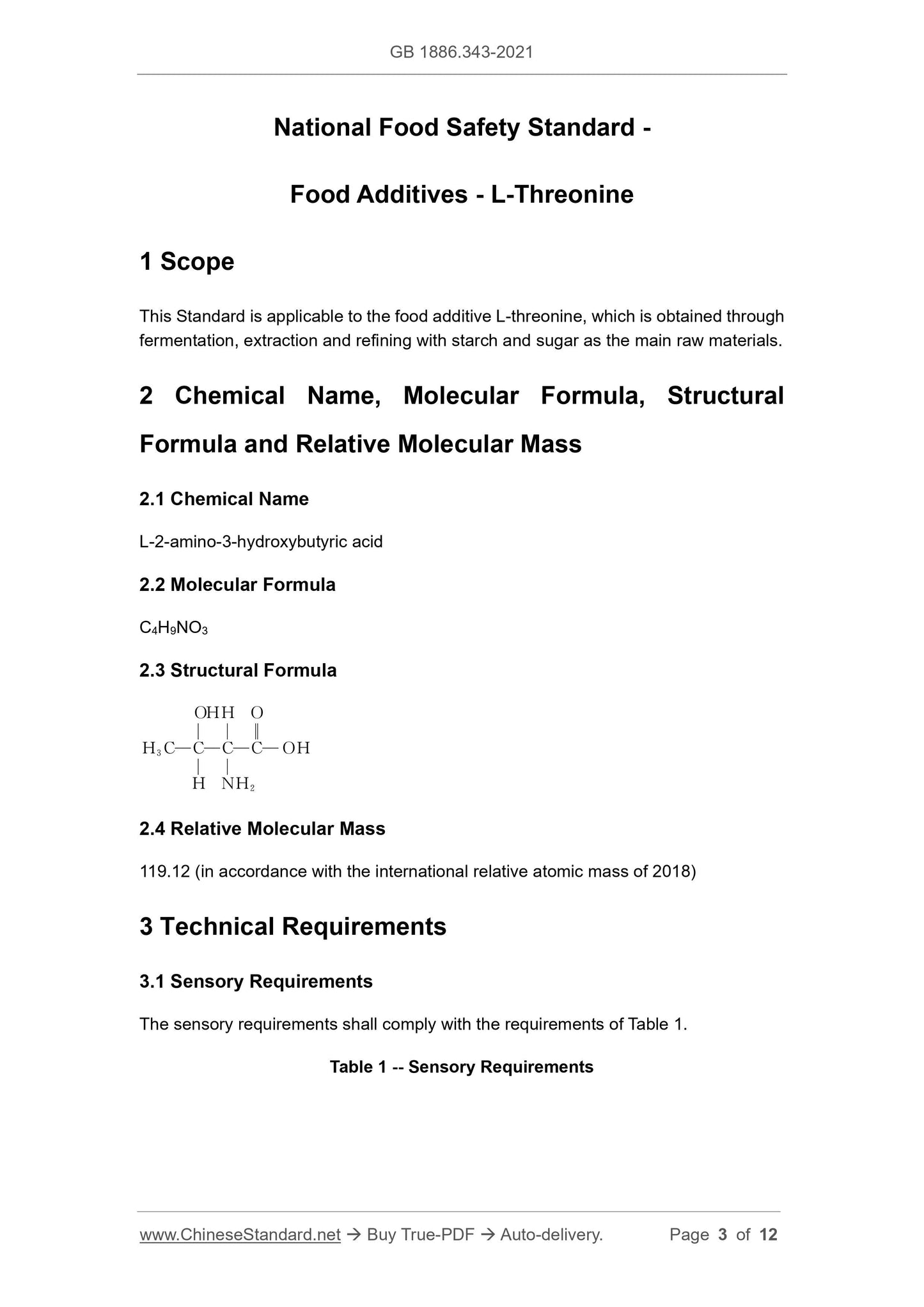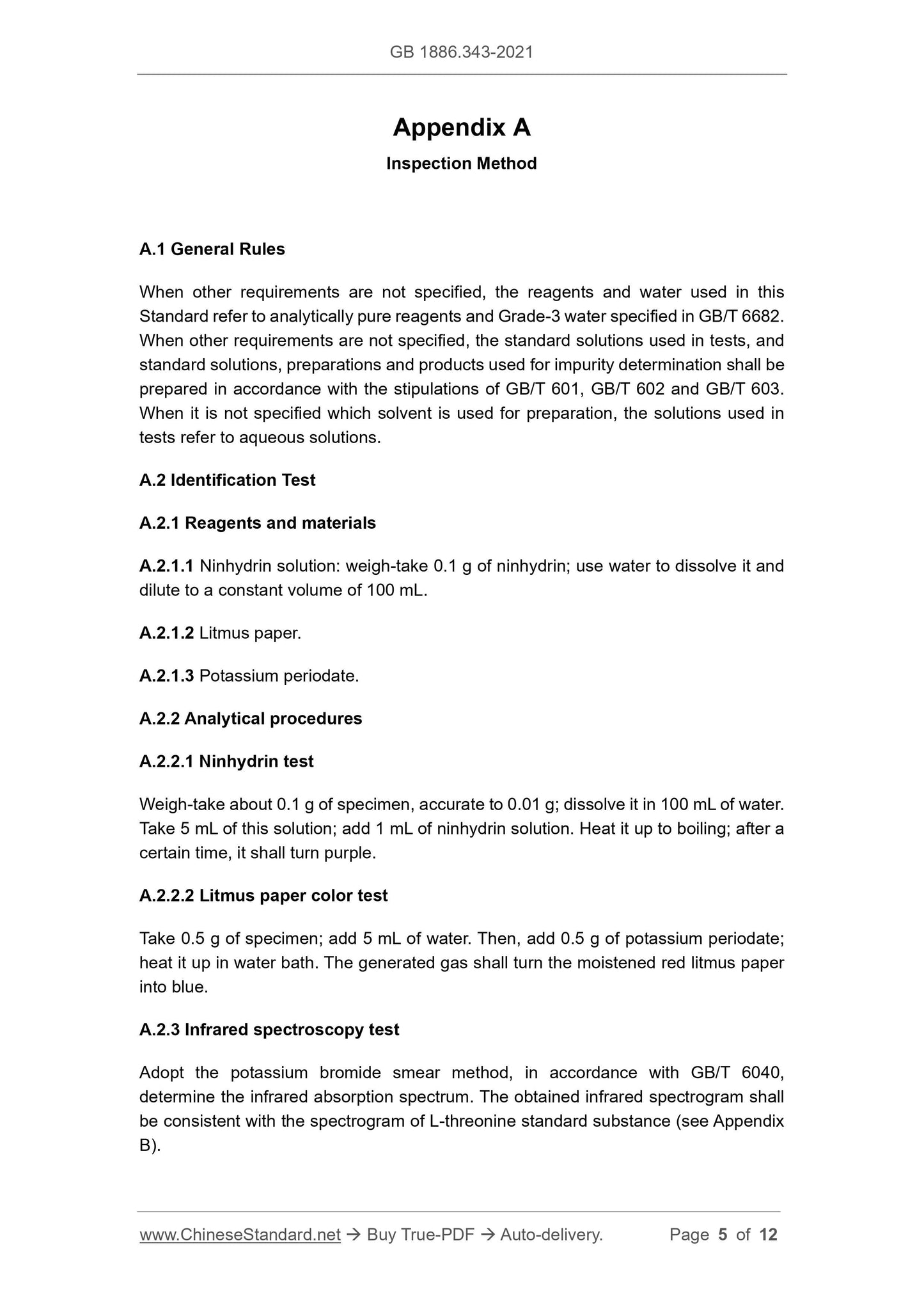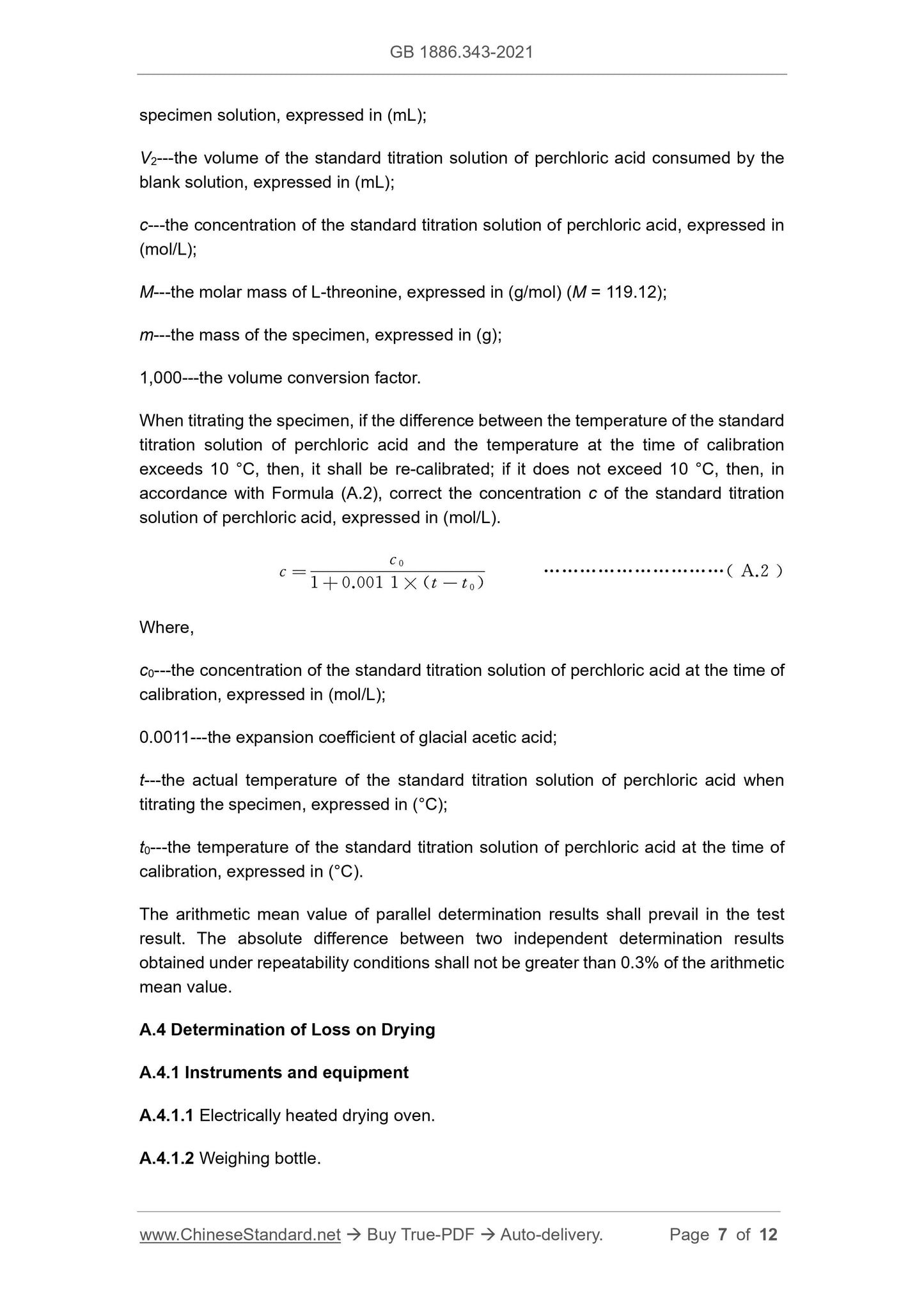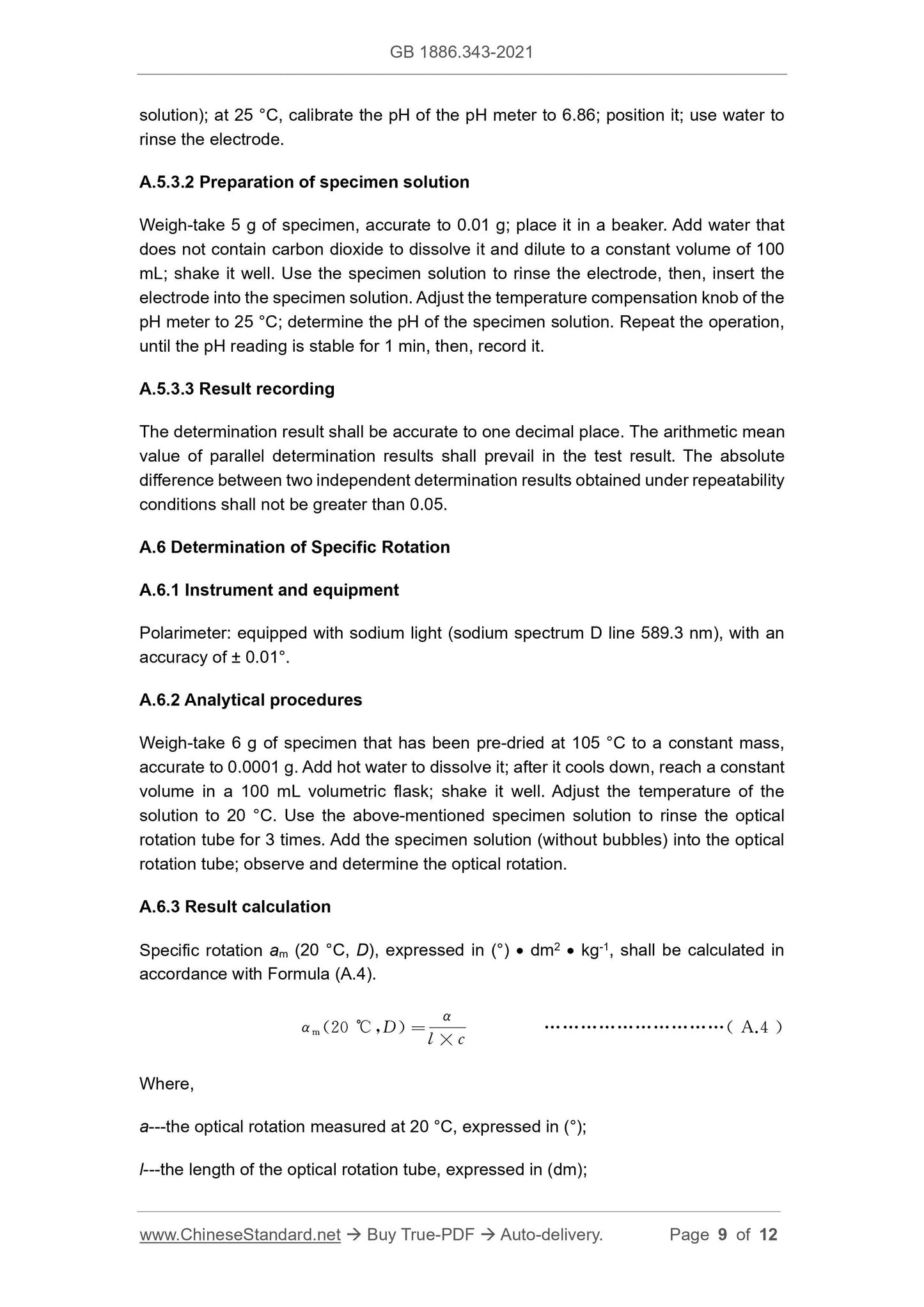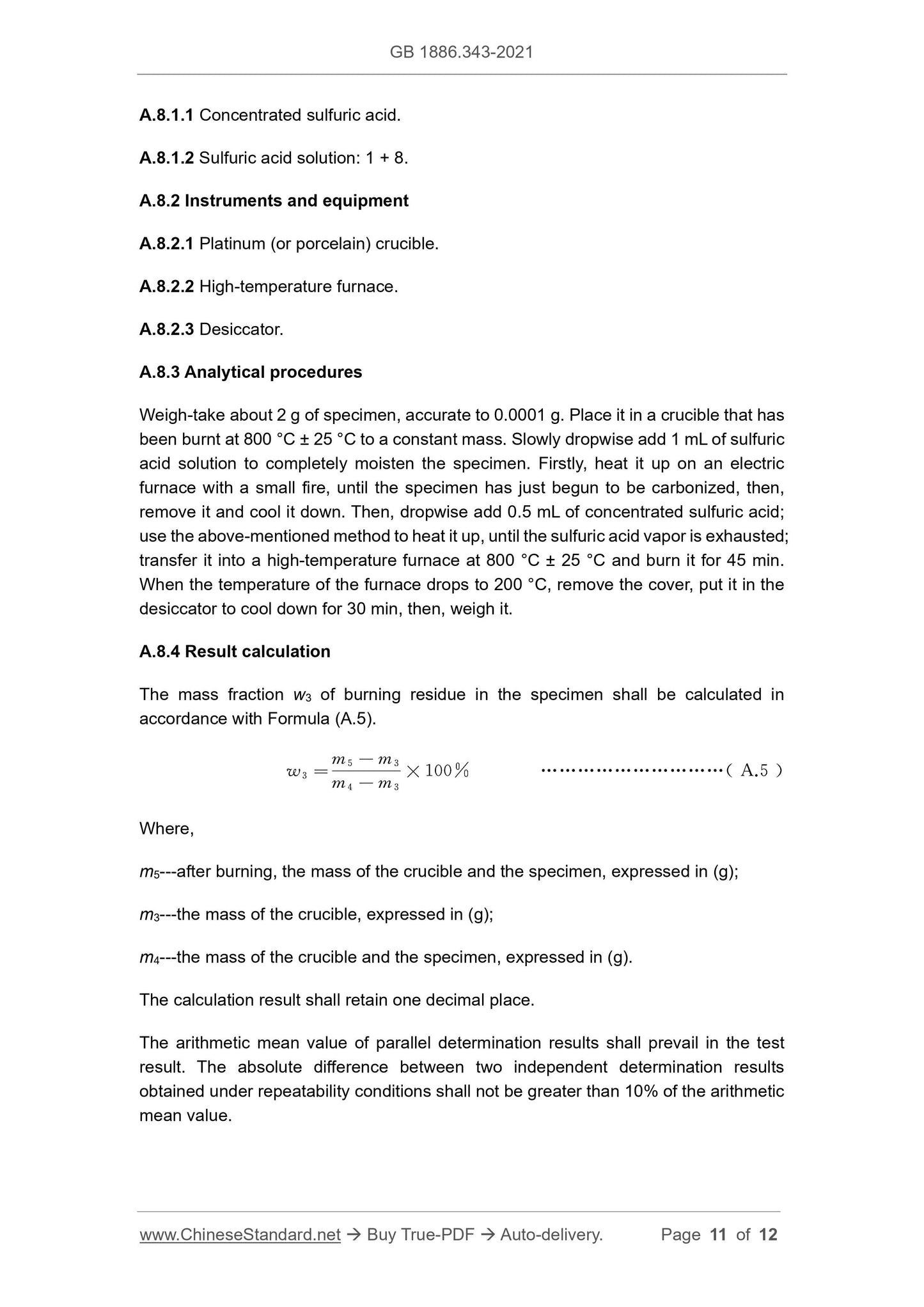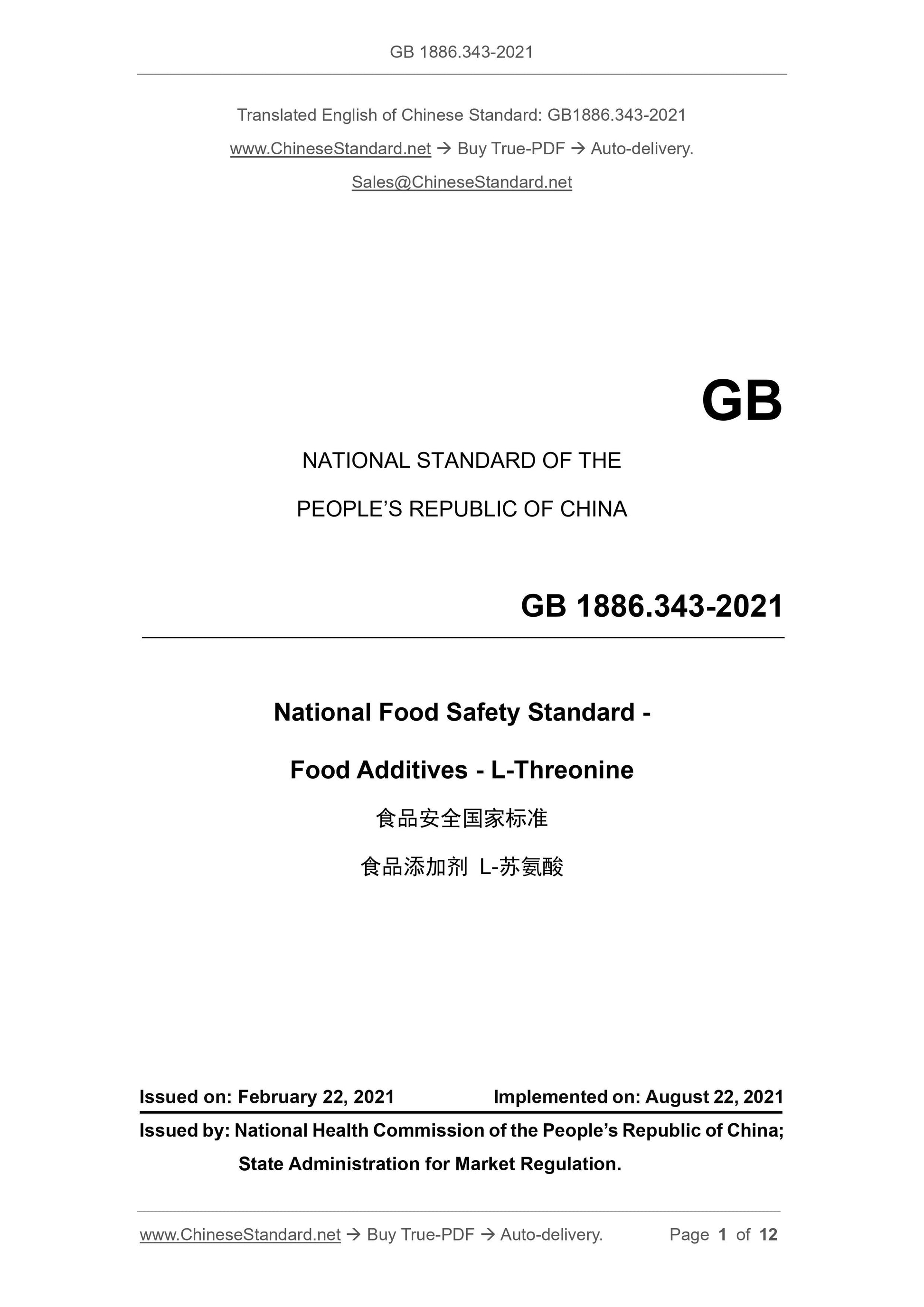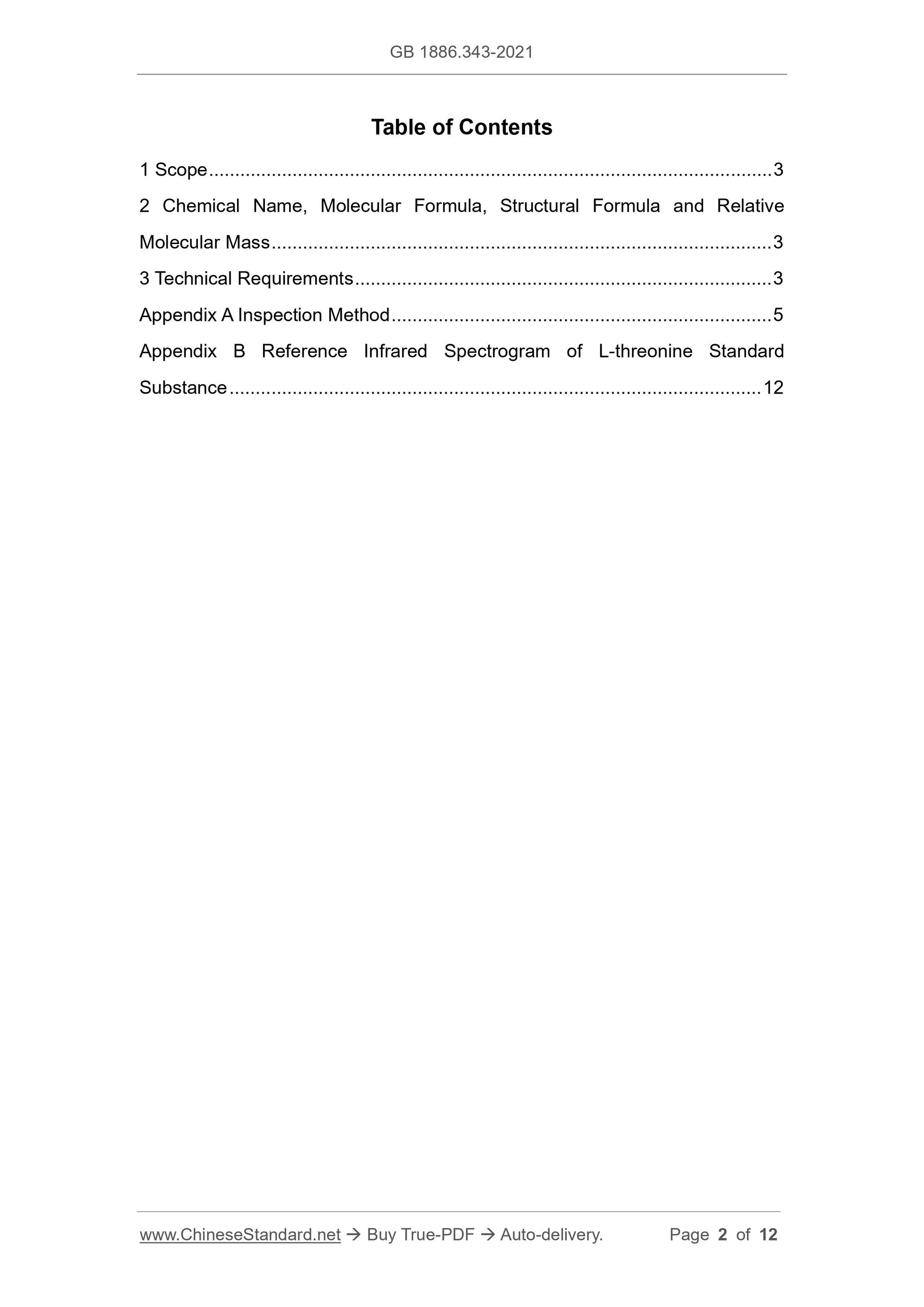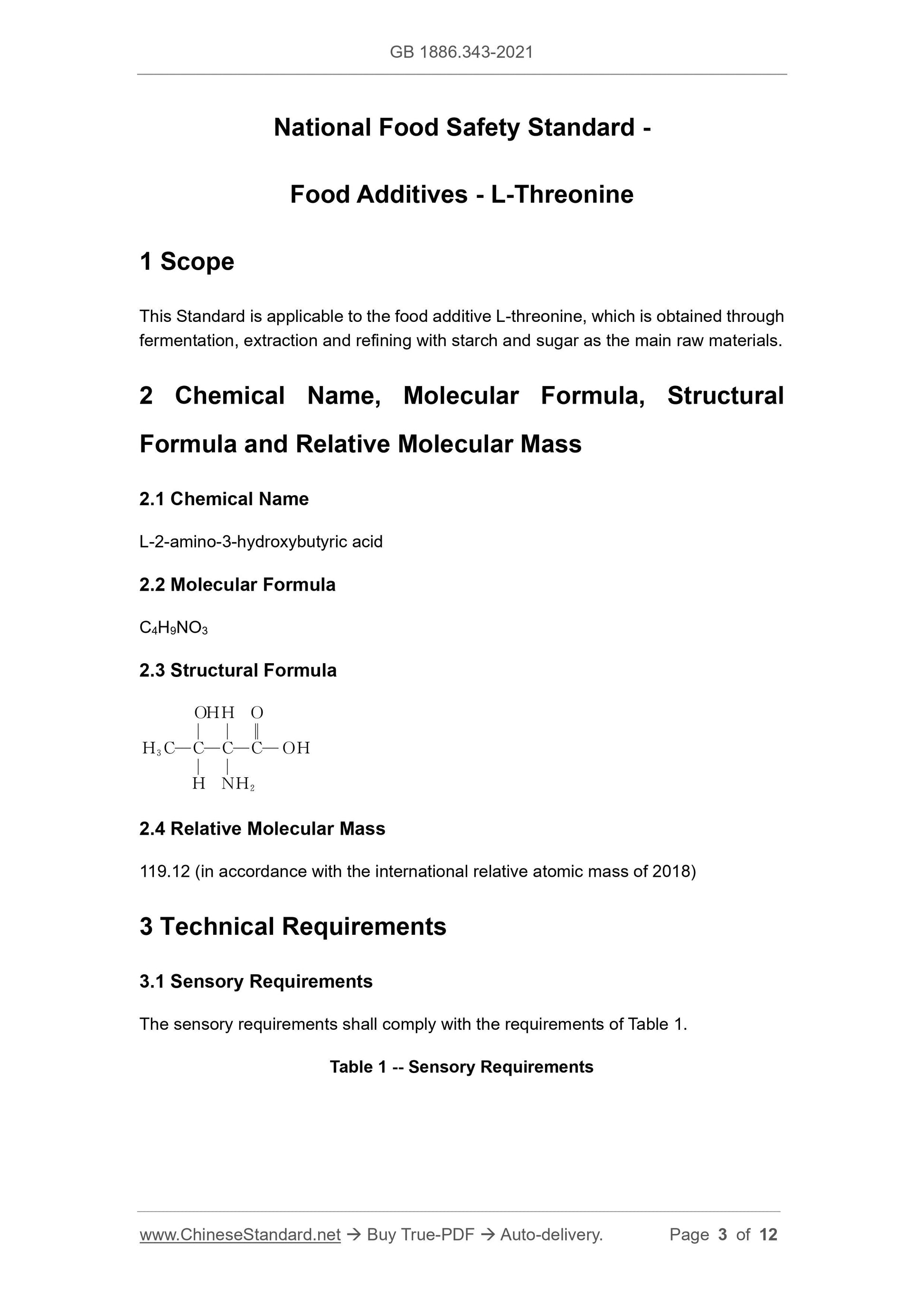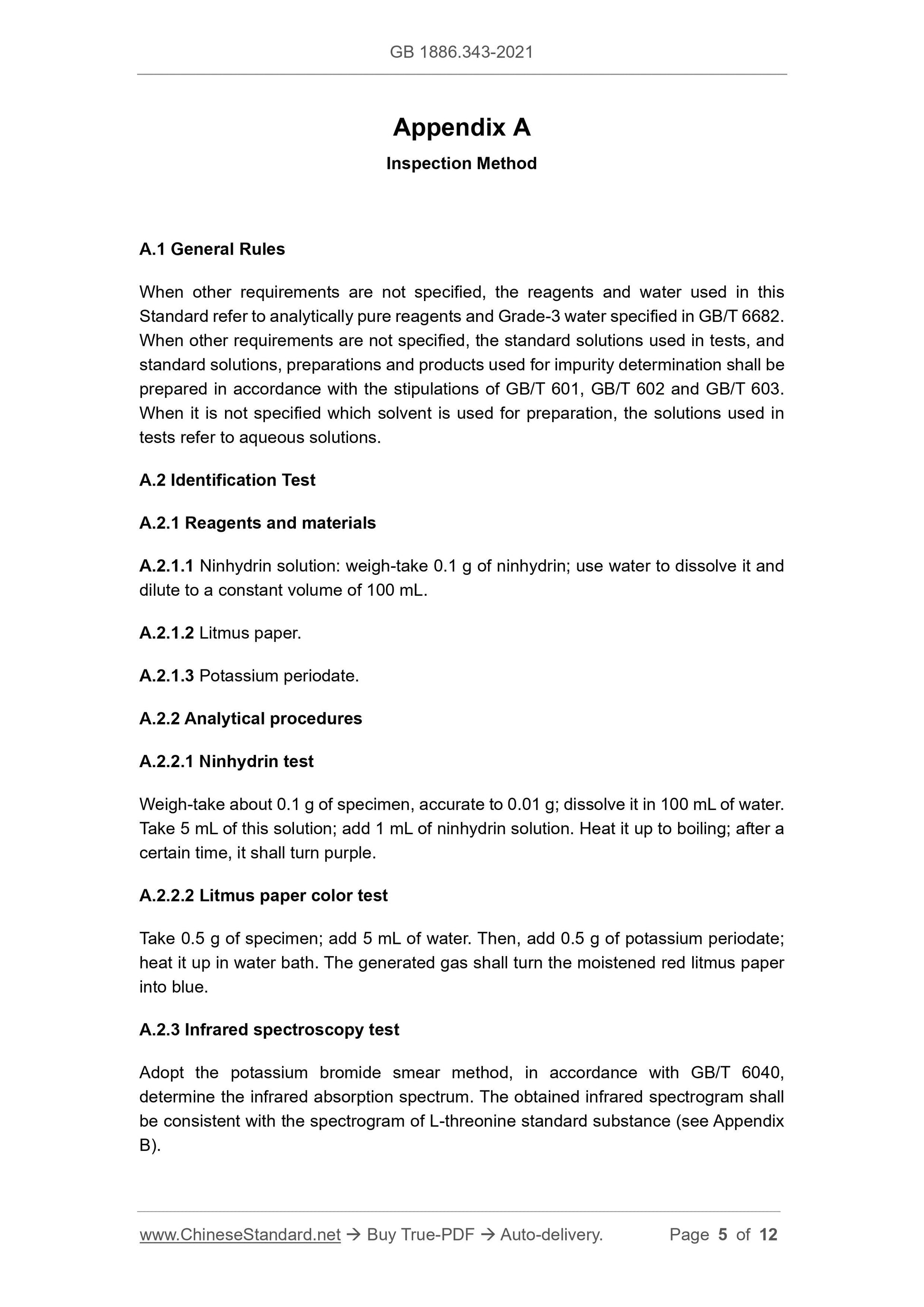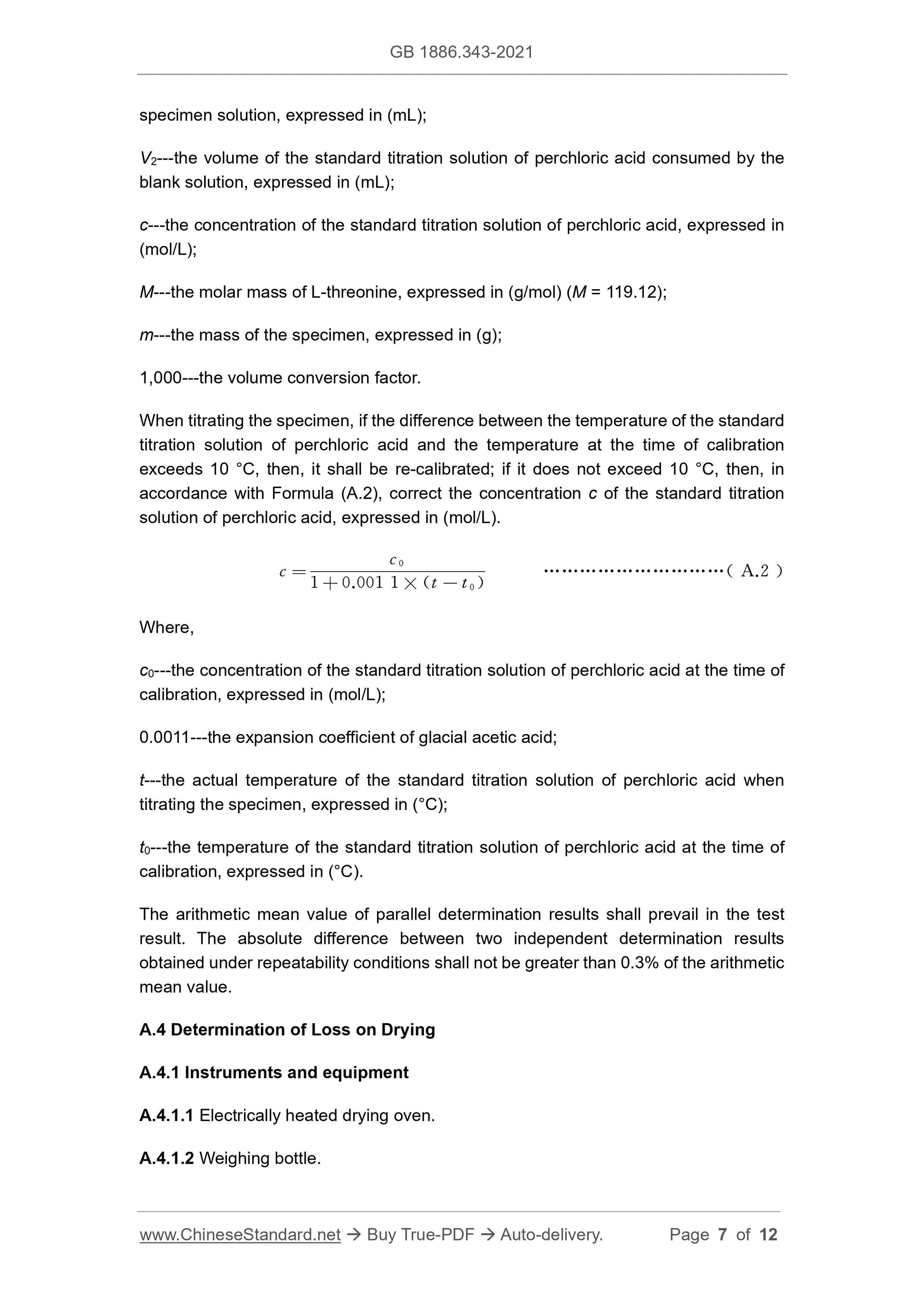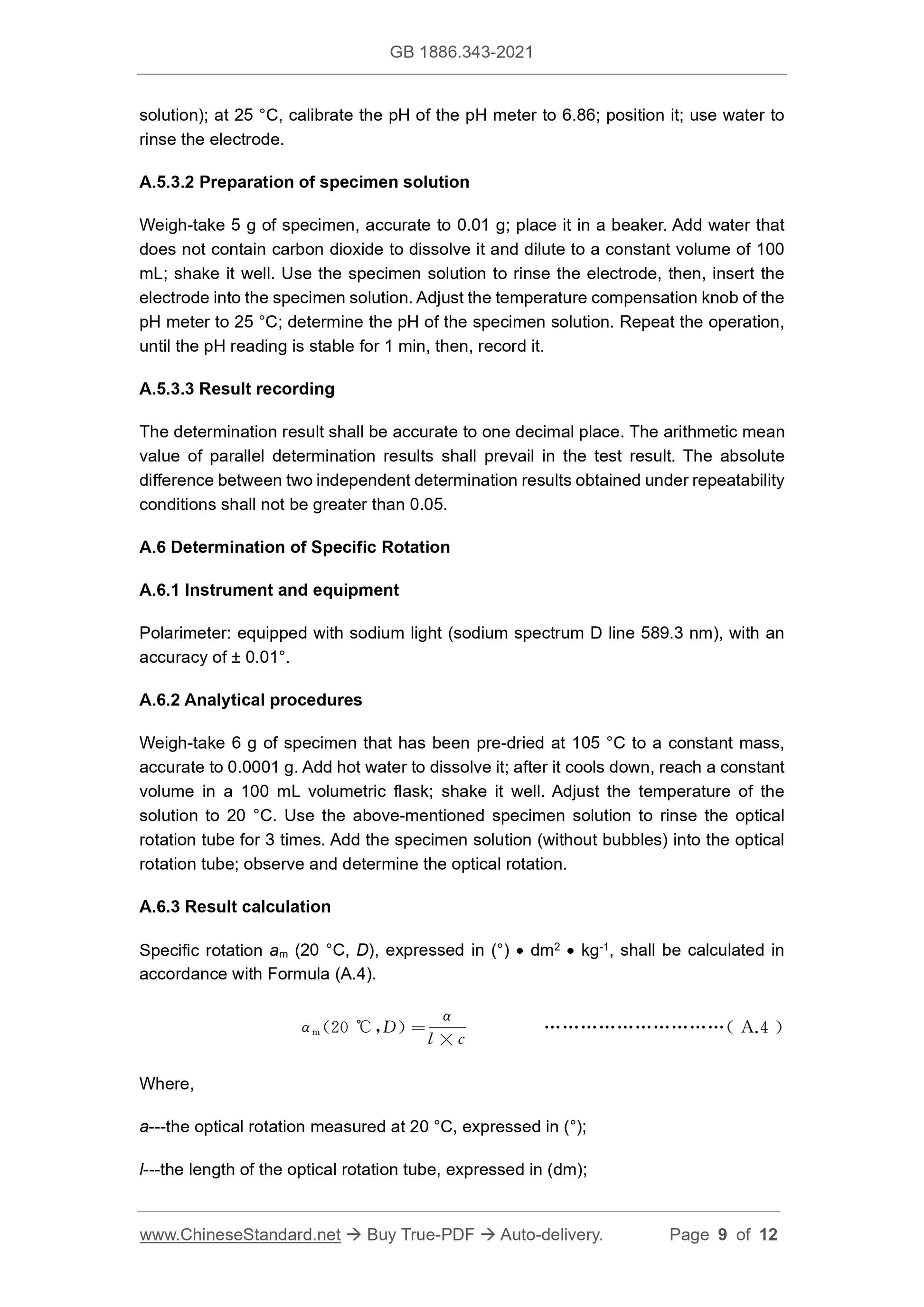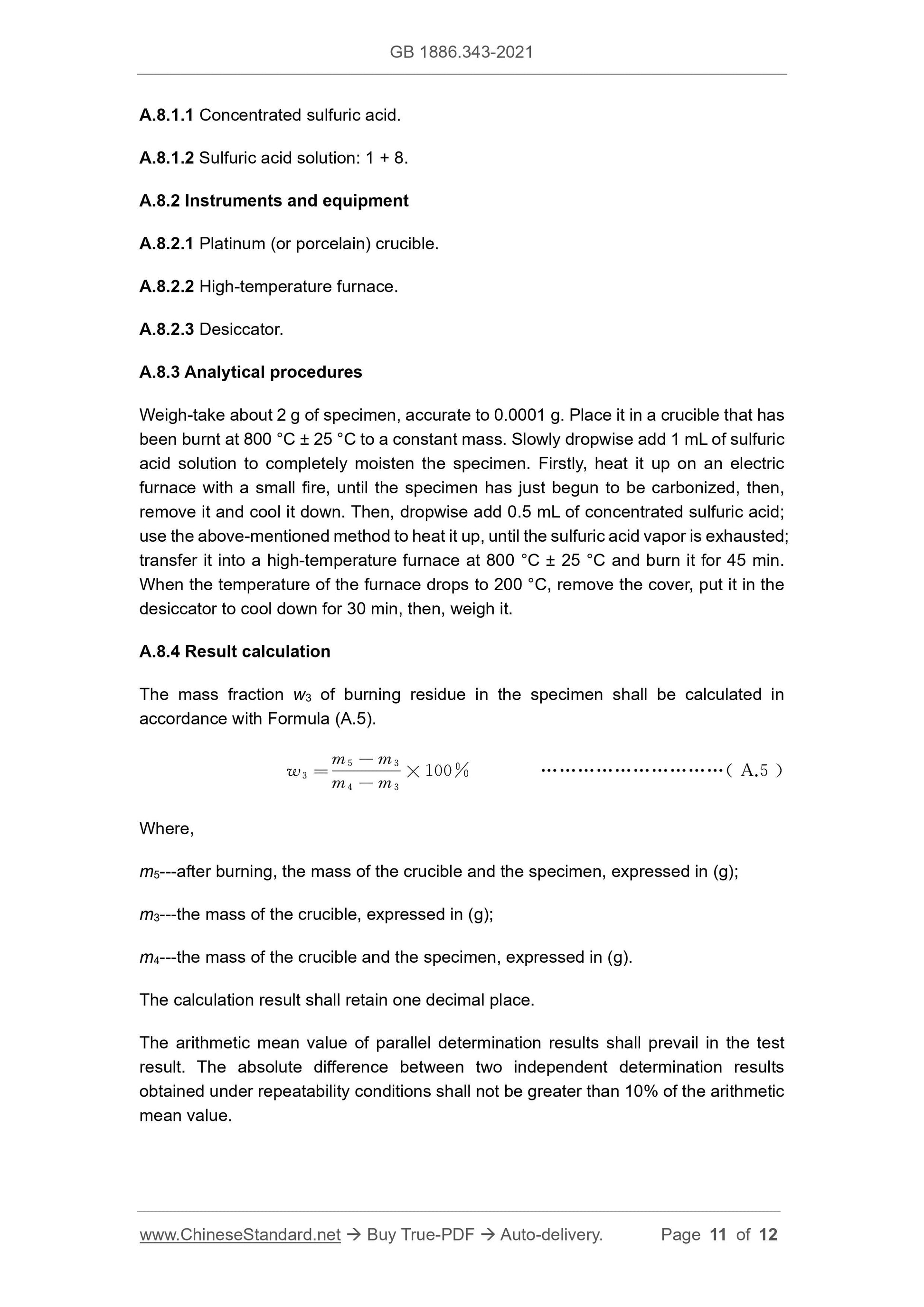1
/
of
7
www.ChineseStandard.us -- Field Test Asia Pte. Ltd.
GB 1886.343-2021 English PDF
GB 1886.343-2021 English PDF
Regular price
$145.00
Regular price
Sale price
$145.00
Unit price
/
per
Shipping calculated at checkout.
Couldn't load pickup availability
GB 1886.343-2021: National food safety standard - Food additives - L-Threonine
Delivery: 9 seconds. Download (& Email) true-PDF + Invoice.
Get Quotation: Click GB 1886.343-2021 (Self-service in 1-minute)
Historical versions (Master-website): GB 1886.343-2021
Preview True-PDF (Reload/Scroll-down if blank)
GB 1886.343-2021
GB
NATIONAL STANDARD OF THE
PEOPLE’S REPUBLIC OF CHINA
National Food Safety Standard -
Food Additives - L-Threonine
食品添加剂 L-苏氨酸
ISSUED ON: FEBRUARY 22, 2021
IMPLEMENTED ON: AUGUST 22, 2021
Issued by: National Health Commission of the People’s Republic of China;
State Administration for Market Regulation.
Table of Contents
1 Scope ... 3
2 Chemical Name, Molecular Formula, Structural Formula and Relative
Molecular Mass ... 3
3 Technical Requirements ... 3
Appendix A Inspection Method ... 5
Appendix B Reference Infrared Spectrogram of L-threonine Standard
Substance ... 12
National Food Safety Standard -
Food Additives - L-Threonine
1 Scope
This Standard is applicable to the food additive L-threonine, which is obtained through
fermentation, extraction and refining with starch and sugar as the main raw materials.
2 Chemical Name, Molecular Formula, Structural
Formula and Relative Molecular Mass
2.1 Chemical Name
L-2-amino-3-hydroxybutyric acid
2.2 Molecular Formula
C4H9NO3
2.3 Structural Formula
2.4 Relative Molecular Mass
119.12 (in accordance with the international relative atomic mass of 2018)
3 Technical Requirements
3.1 Sensory Requirements
The sensory requirements shall comply with the requirements of Table 1.
Table 1 -- Sensory Requirements
Appendix A
Inspection Method
A.1 General Rules
When other requirements are not specified, the reagents and water used in this
Standard refer to analytically pure reagents and Grade-3 water specified in GB/T 6682.
When other requirements are not specified, the standard solutions used in tests, and
standard solutions, preparations and products used for impurity determination shall be
prepared in accordance with the stipulations of GB/T 601, GB/T 602 and GB/T 603.
When it is not specified which solvent is used for preparation, the solutions used in
tests refer to aqueous solutions.
A.2 Identification Test
A.2.1 Reagents and materials
A.2.1.1 Ninhydrin solution: weigh-take 0.1 g of ninhydrin; use water to dissolve it and
dilute to a constant volume of 100 mL.
A.2.1.2 Litmus paper.
A.2.1.3 Potassium periodate.
A.2.2 Analytical procedures
A.2.2.1 Ninhydrin test
Weigh-take about 0.1 g of specimen, accurate to 0.01 g; dissolve it in 100 mL of water.
Take 5 mL of this solution; add 1 mL of ninhydrin solution. Heat it up to boiling; after a
certain time, it shall turn purple.
A.2.2.2 Litmus paper color test
Take 0.5 g of specimen; add 5 mL of water. Then, add 0.5 g of potassium periodate;
heat it up in water bath. The generated gas shall turn the moistened red litmus paper
into blue.
A.2.3 Infrared spectroscopy test
Adopt the potassium bromide smear method, in accordance with GB/T 6040,
determine the infrared absorption spectrum. The obtained infrared spectrogram shall
be consistent with the spectrogram of L-threonine standard substance (see Appendix
B).
specimen solution, expressed in (mL);
V2---the volume of the standard titration solution of perchloric acid consumed by the
blank solution, expressed in (mL);
c---the concentration of the standard titration solution of perchloric acid, expressed in
(mol/L);
M---the molar mass of L-threonine, expressed in (g/mol) (M = 119.12);
m---the mass of the specimen, expressed in (g);
1,000---the volume conversion factor.
When titrating the specimen, if the difference between the temperature of the standard
titration solution of perchloric acid and the temperature at the time of calibration
exceeds 10 °C, then, it shall be re-calibrated; if it does not exceed 10 °C, then, in
accordance with Formula (A.2), correct the concentration c of the standard titration
solution of perchloric acid, expressed in (mol/L).
Where,
c0---the concentration of the standard titration solution of perchloric acid at the time of
calibration, expressed in (mol/L);
0.0011---the expansion coefficient of glacial acetic acid;
t---the actual temperature of the standard titration solution of perchloric acid when
titrating the specimen, expressed in (°C);
t0---the temperature of the standard titration solution of perchloric acid at the time of
calibration, expressed in (°C).
The arithmetic mean value of parallel determination results shall prevail in the test
result. The absolute difference between two independent determination results
obtained under repeatability conditions shall not be greater than 0.3% of the arithmetic
mean value.
A.4 Determination of Loss on Drying
A.4.1 Instruments and equipment
A.4.1.1 Electrically heated drying oven.
A.4.1.2 Weighing bottle.
solution); at 25 °C, calibrate the pH of the pH meter to 6.86; position it; use water to
rinse the electrode.
A.5.3.2 Preparation of specimen solution
Weigh-take 5 g of specimen, accurate to 0.01 g; place it in a beaker. Add water that
does not contain carbon dioxide to dissolve it and dilute to a constant volume of 100
mL; shake it well. Use the specimen solution to rinse the electrode, then, insert the
electrode into the specimen solution. Adjust the temperature compensation knob of the
pH meter to 25 °C; determine the pH of the specimen solution. Repeat the operation,
until the pH reading is stable for 1 min, then, record it.
A.5.3.3 Result recording
The determination result shall be accurate to one decimal place. The arithmetic mean
value of parallel determination results shall prevail in the test result. The absolute
difference between two independent determination results obtained under repeatability
conditions shall not be greater than 0.05.
A.6 Determination of Specific Rotation
A.6.1 Instrument and equipment
Polarimeter: equipped with sodium light (sodium spectrum D line 589.3 nm), with an
accuracy of ± 0.01°.
A.6.2 Analytical procedures
Weigh-take 6 g of specimen that has been pre-dried at 105 °C to a constant mass,
accurate to 0.0001 g. Add hot water to dissolve it; after it cools down, reach a constant
volume in a 100 mL volumetric flask; shake it well. Adjust the temperature of the
solution to 20 °C. Use the above-mentioned specimen solution to rinse the optical
rotation tube for 3 times. Add the specimen solution (without bubbles) into the optical
rotation tube; observe and determine the optical rotation.
A.6.3 Result calculation
Specific rotation am (20 °C, D), expressed in (°) dm2 kg-1, shall be calculated in
accordance with Formula (A.4).
Where,
a---the optical rotation measured at 20 °C, expressed in (°);
l---the length of the optical rotation tube, expressed in (dm);
A.8.1.1 Concentrated sulfuric acid.
A.8.1.2 Sulfuric acid solution: 1 + 8.
A.8.2 Instruments and equipment
A.8.2.1 Platinum (or porcelain) crucible.
A.8.2.2 High-temperature furnace.
A.8.2.3 Desiccator.
A.8.3 Analytical procedures
Weigh-take about 2 g of specimen, accurate to 0.0001 g. Place it in a crucible that has
been burnt at 800 °C ± 25 °C to a constant mass. Slowly dropwise add 1 mL of sulfuric
acid solution to completely moisten the specimen. Firstly, heat it up on an electric
furnace with a small fire, until the specimen has just begun to be carbonized, then,
remove it and cool it down. Then, dropwise add 0.5 mL of concentrated sulfuric acid;
use the above-mentioned method to heat it up, until the sulfuric acid vapor is exhausted;
transfer it into a high-temperature furnace at 800 °C ± 25 °C and burn it for 45 min.
When the temperature of the furnace drops to 200 °C, remove the cover, put it in the
desiccator to cool down for 30 min, then, weigh it.
A.8.4 Result calculation
The mass fraction w3 of burning residue in the specimen shall be calculated in
accordance with Formula (A.5).
Where,
m5---after burning, the mass of the crucible and the specimen, expressed in (g);
m3---the mass of the crucible, expressed in (g);
m4---the mass of the crucible and the specimen, expressed in (g).
The calculation result shall retain one decimal place.
The arithmetic mean value of parallel determination results shall prevail in the test
result. The absolute difference between two independent determination results
obtained under repeatability conditions shall not be greater than 10% of the arithmetic
mean value.
GB 1886.343-2021
GB
NATIONAL STANDARD OF THE
PEOPLE’S REPUBLIC OF CHINA
National Food Safety Standard -
Food Additives - L-Threonine
食品添加剂 L-苏氨酸
ISSUED ON: FEBRUARY 22, 2021
IMPLEMENTED ON: AUGUST 22, 2021
Issued by: National Health Commission of the People’s Republic of China;
State Administration for Market Regulation.
Table of Contents
1 Scope ... 3
2 Chemical Name, Molecular Formula, Structural Formula and Relative
Molecular Mass ... 3
3 Technical Requirements ... 3
Appendix A Inspection Method ... 5
Appendix B Reference Infrared Spectrogram of L-threonine Standard
Substance ... 12
National Food Safety Standard -
Food Additives - L-Threonine
1 Scope
This Standard is applicable to the food additive L-threonine, which is obtained through
fermentation, extraction and refining with starch and sugar as the main raw materials.
2 Chemical Name, Molecular Formula, Structural
Formula and Relative Molecular Mass
2.1 Chemical Name
L-2-amino-3-hydroxybutyric acid
2.2 Molecular Formula
C4H9NO3
2.3 Structural Formula
2.4 Relative Molecular Mass
119.12 (in accordance with the international relative atomic mass of 2018)
3 Technical Requirements
3.1 Sensory Requirements
The sensory requirements shall comply with the requirements of Table 1.
Table 1 -- Sensory Requirements
Appendix A
Inspection Method
A.1 General Rules
When other requirements are not specified, the reagents and water used in this
Standard refer to analytically pure reagents and Grade-3 water specified in GB/T 6682.
When other requirements are not specified, the standard solutions used in tests, and
standard solutions, preparations and products used for impurity determination shall be
prepared in accordance with the stipulations of GB/T 601, GB/T 602 and GB/T 603.
When it is not specified which solvent is used for preparation, the solutions used in
tests refer to aqueous solutions.
A.2 Identification Test
A.2.1 Reagents and materials
A.2.1.1 Ninhydrin solution: weigh-take 0.1 g of ninhydrin; use water to dissolve it and
dilute to a constant volume of 100 mL.
A.2.1.2 Litmus paper.
A.2.1.3 Potassium periodate.
A.2.2 Analytical procedures
A.2.2.1 Ninhydrin test
Weigh-take about 0.1 g of specimen, accurate to 0.01 g; dissolve it in 100 mL of water.
Take 5 mL of this solution; add 1 mL of ninhydrin solution. Heat it up to boiling; after a
certain time, it shall turn purple.
A.2.2.2 Litmus paper color test
Take 0.5 g of specimen; add 5 mL of water. Then, add 0.5 g of potassium periodate;
heat it up in water bath. The generated gas shall turn the moistened red litmus paper
into blue.
A.2.3 Infrared spectroscopy test
Adopt the potassium bromide smear method, in accordance with GB/T 6040,
determine the infrared absorption spectrum. The obtained infrared spectrogram shall
be consistent with the spectrogram of L-threonine standard substance (see Appendix
B).
specimen solution, expressed in (mL);
V2---the volume of the standard titration solution of perchloric acid consumed by the
blank solution, expressed in (mL);
c---the concentration of the standard titration solution of perchloric acid, expressed in
(mol/L);
M---the molar mass of L-threonine, expressed in (g/mol) (M = 119.12);
m---the mass of the specimen, expressed in (g);
1,000---the volume conversion factor.
When titrating the specimen, if the difference between the temperature of the standard
titration solution of perchloric acid and the temperature at the time of calibration
exceeds 10 °C, then, it shall be re-calibrated; if it does not exceed 10 °C, then, in
accordance with Formula (A.2), correct the concentration c of the standard titration
solution of perchloric acid, expressed in (mol/L).
Where,
c0---the concentration of the standard titration solution of perchloric acid at the time of
calibration, expressed in (mol/L);
0.0011---the expansion coefficient of glacial acetic acid;
t---the actual temperature of the standard titration solution of perchloric acid when
titrating the specimen, expressed in (°C);
t0---the temperature of the standard titration solution of perchloric acid at the time of
calibration, expressed in (°C).
The arithmetic mean value of parallel determination results shall prevail in the test
result. The absolute difference between two independent determination results
obtained under repeatability conditions shall not be greater than 0.3% of the arithmetic
mean value.
A.4 Determination of Loss on Drying
A.4.1 Instruments and equipment
A.4.1.1 Electrically heated drying oven.
A.4.1.2 Weighing bottle.
solution); at 25 °C, calibrate the pH of the pH meter to 6.86; position it; use water to
rinse the electrode.
A.5.3.2 Preparation of specimen solution
Weigh-take 5 g of specimen, accurate to 0.01 g; place it in a beaker. Add water that
does not contain carbon dioxide to dissolve it and dilute to a constant volume of 100
mL; shake it well. Use the specimen solution to rinse the electrode, then, insert the
electrode into the specimen solution. Adjust the temperature compensation knob of the
pH meter to 25 °C; determine the pH of the specimen solution. Repeat the operation,
until the pH reading is stable for 1 min, then, record it.
A.5.3.3 Result recording
The determination result shall be accurate to one decimal place. The arithmetic mean
value of parallel determination results shall prevail in the test result. The absolute
difference between two independent determination results obtained under repeatability
conditions shall not be greater than 0.05.
A.6 Determination of Specific Rotation
A.6.1 Instrument and equipment
Polarimeter: equipped with sodium light (sodium spectrum D line 5...
Delivery: 9 seconds. Download (& Email) true-PDF + Invoice.
Get Quotation: Click GB 1886.343-2021 (Self-service in 1-minute)
Historical versions (Master-website): GB 1886.343-2021
Preview True-PDF (Reload/Scroll-down if blank)
GB 1886.343-2021
GB
NATIONAL STANDARD OF THE
PEOPLE’S REPUBLIC OF CHINA
National Food Safety Standard -
Food Additives - L-Threonine
食品添加剂 L-苏氨酸
ISSUED ON: FEBRUARY 22, 2021
IMPLEMENTED ON: AUGUST 22, 2021
Issued by: National Health Commission of the People’s Republic of China;
State Administration for Market Regulation.
Table of Contents
1 Scope ... 3
2 Chemical Name, Molecular Formula, Structural Formula and Relative
Molecular Mass ... 3
3 Technical Requirements ... 3
Appendix A Inspection Method ... 5
Appendix B Reference Infrared Spectrogram of L-threonine Standard
Substance ... 12
National Food Safety Standard -
Food Additives - L-Threonine
1 Scope
This Standard is applicable to the food additive L-threonine, which is obtained through
fermentation, extraction and refining with starch and sugar as the main raw materials.
2 Chemical Name, Molecular Formula, Structural
Formula and Relative Molecular Mass
2.1 Chemical Name
L-2-amino-3-hydroxybutyric acid
2.2 Molecular Formula
C4H9NO3
2.3 Structural Formula
2.4 Relative Molecular Mass
119.12 (in accordance with the international relative atomic mass of 2018)
3 Technical Requirements
3.1 Sensory Requirements
The sensory requirements shall comply with the requirements of Table 1.
Table 1 -- Sensory Requirements
Appendix A
Inspection Method
A.1 General Rules
When other requirements are not specified, the reagents and water used in this
Standard refer to analytically pure reagents and Grade-3 water specified in GB/T 6682.
When other requirements are not specified, the standard solutions used in tests, and
standard solutions, preparations and products used for impurity determination shall be
prepared in accordance with the stipulations of GB/T 601, GB/T 602 and GB/T 603.
When it is not specified which solvent is used for preparation, the solutions used in
tests refer to aqueous solutions.
A.2 Identification Test
A.2.1 Reagents and materials
A.2.1.1 Ninhydrin solution: weigh-take 0.1 g of ninhydrin; use water to dissolve it and
dilute to a constant volume of 100 mL.
A.2.1.2 Litmus paper.
A.2.1.3 Potassium periodate.
A.2.2 Analytical procedures
A.2.2.1 Ninhydrin test
Weigh-take about 0.1 g of specimen, accurate to 0.01 g; dissolve it in 100 mL of water.
Take 5 mL of this solution; add 1 mL of ninhydrin solution. Heat it up to boiling; after a
certain time, it shall turn purple.
A.2.2.2 Litmus paper color test
Take 0.5 g of specimen; add 5 mL of water. Then, add 0.5 g of potassium periodate;
heat it up in water bath. The generated gas shall turn the moistened red litmus paper
into blue.
A.2.3 Infrared spectroscopy test
Adopt the potassium bromide smear method, in accordance with GB/T 6040,
determine the infrared absorption spectrum. The obtained infrared spectrogram shall
be consistent with the spectrogram of L-threonine standard substance (see Appendix
B).
specimen solution, expressed in (mL);
V2---the volume of the standard titration solution of perchloric acid consumed by the
blank solution, expressed in (mL);
c---the concentration of the standard titration solution of perchloric acid, expressed in
(mol/L);
M---the molar mass of L-threonine, expressed in (g/mol) (M = 119.12);
m---the mass of the specimen, expressed in (g);
1,000---the volume conversion factor.
When titrating the specimen, if the difference between the temperature of the standard
titration solution of perchloric acid and the temperature at the time of calibration
exceeds 10 °C, then, it shall be re-calibrated; if it does not exceed 10 °C, then, in
accordance with Formula (A.2), correct the concentration c of the standard titration
solution of perchloric acid, expressed in (mol/L).
Where,
c0---the concentration of the standard titration solution of perchloric acid at the time of
calibration, expressed in (mol/L);
0.0011---the expansion coefficient of glacial acetic acid;
t---the actual temperature of the standard titration solution of perchloric acid when
titrating the specimen, expressed in (°C);
t0---the temperature of the standard titration solution of perchloric acid at the time of
calibration, expressed in (°C).
The arithmetic mean value of parallel determination results shall prevail in the test
result. The absolute difference between two independent determination results
obtained under repeatability conditions shall not be greater than 0.3% of the arithmetic
mean value.
A.4 Determination of Loss on Drying
A.4.1 Instruments and equipment
A.4.1.1 Electrically heated drying oven.
A.4.1.2 Weighing bottle.
solution); at 25 °C, calibrate the pH of the pH meter to 6.86; position it; use water to
rinse the electrode.
A.5.3.2 Preparation of specimen solution
Weigh-take 5 g of specimen, accurate to 0.01 g; place it in a beaker. Add water that
does not contain carbon dioxide to dissolve it and dilute to a constant volume of 100
mL; shake it well. Use the specimen solution to rinse the electrode, then, insert the
electrode into the specimen solution. Adjust the temperature compensation knob of the
pH meter to 25 °C; determine the pH of the specimen solution. Repeat the operation,
until the pH reading is stable for 1 min, then, record it.
A.5.3.3 Result recording
The determination result shall be accurate to one decimal place. The arithmetic mean
value of parallel determination results shall prevail in the test result. The absolute
difference between two independent determination results obtained under repeatability
conditions shall not be greater than 0.05.
A.6 Determination of Specific Rotation
A.6.1 Instrument and equipment
Polarimeter: equipped with sodium light (sodium spectrum D line 589.3 nm), with an
accuracy of ± 0.01°.
A.6.2 Analytical procedures
Weigh-take 6 g of specimen that has been pre-dried at 105 °C to a constant mass,
accurate to 0.0001 g. Add hot water to dissolve it; after it cools down, reach a constant
volume in a 100 mL volumetric flask; shake it well. Adjust the temperature of the
solution to 20 °C. Use the above-mentioned specimen solution to rinse the optical
rotation tube for 3 times. Add the specimen solution (without bubbles) into the optical
rotation tube; observe and determine the optical rotation.
A.6.3 Result calculation
Specific rotation am (20 °C, D), expressed in (°) dm2 kg-1, shall be calculated in
accordance with Formula (A.4).
Where,
a---the optical rotation measured at 20 °C, expressed in (°);
l---the length of the optical rotation tube, expressed in (dm);
A.8.1.1 Concentrated sulfuric acid.
A.8.1.2 Sulfuric acid solution: 1 + 8.
A.8.2 Instruments and equipment
A.8.2.1 Platinum (or porcelain) crucible.
A.8.2.2 High-temperature furnace.
A.8.2.3 Desiccator.
A.8.3 Analytical procedures
Weigh-take about 2 g of specimen, accurate to 0.0001 g. Place it in a crucible that has
been burnt at 800 °C ± 25 °C to a constant mass. Slowly dropwise add 1 mL of sulfuric
acid solution to completely moisten the specimen. Firstly, heat it up on an electric
furnace with a small fire, until the specimen has just begun to be carbonized, then,
remove it and cool it down. Then, dropwise add 0.5 mL of concentrated sulfuric acid;
use the above-mentioned method to heat it up, until the sulfuric acid vapor is exhausted;
transfer it into a high-temperature furnace at 800 °C ± 25 °C and burn it for 45 min.
When the temperature of the furnace drops to 200 °C, remove the cover, put it in the
desiccator to cool down for 30 min, then, weigh it.
A.8.4 Result calculation
The mass fraction w3 of burning residue in the specimen shall be calculated in
accordance with Formula (A.5).
Where,
m5---after burning, the mass of the crucible and the specimen, expressed in (g);
m3---the mass of the crucible, expressed in (g);
m4---the mass of the crucible and the specimen, expressed in (g).
The calculation result shall retain one decimal place.
The arithmetic mean value of parallel determination results shall prevail in the test
result. The absolute difference between two independent determination results
obtained under repeatability conditions shall not be greater than 10% of the arithmetic
mean value.
GB 1886.343-2021
GB
NATIONAL STANDARD OF THE
PEOPLE’S REPUBLIC OF CHINA
National Food Safety Standard -
Food Additives - L-Threonine
食品添加剂 L-苏氨酸
ISSUED ON: FEBRUARY 22, 2021
IMPLEMENTED ON: AUGUST 22, 2021
Issued by: National Health Commission of the People’s Republic of China;
State Administration for Market Regulation.
Table of Contents
1 Scope ... 3
2 Chemical Name, Molecular Formula, Structural Formula and Relative
Molecular Mass ... 3
3 Technical Requirements ... 3
Appendix A Inspection Method ... 5
Appendix B Reference Infrared Spectrogram of L-threonine Standard
Substance ... 12
National Food Safety Standard -
Food Additives - L-Threonine
1 Scope
This Standard is applicable to the food additive L-threonine, which is obtained through
fermentation, extraction and refining with starch and sugar as the main raw materials.
2 Chemical Name, Molecular Formula, Structural
Formula and Relative Molecular Mass
2.1 Chemical Name
L-2-amino-3-hydroxybutyric acid
2.2 Molecular Formula
C4H9NO3
2.3 Structural Formula
2.4 Relative Molecular Mass
119.12 (in accordance with the international relative atomic mass of 2018)
3 Technical Requirements
3.1 Sensory Requirements
The sensory requirements shall comply with the requirements of Table 1.
Table 1 -- Sensory Requirements
Appendix A
Inspection Method
A.1 General Rules
When other requirements are not specified, the reagents and water used in this
Standard refer to analytically pure reagents and Grade-3 water specified in GB/T 6682.
When other requirements are not specified, the standard solutions used in tests, and
standard solutions, preparations and products used for impurity determination shall be
prepared in accordance with the stipulations of GB/T 601, GB/T 602 and GB/T 603.
When it is not specified which solvent is used for preparation, the solutions used in
tests refer to aqueous solutions.
A.2 Identification Test
A.2.1 Reagents and materials
A.2.1.1 Ninhydrin solution: weigh-take 0.1 g of ninhydrin; use water to dissolve it and
dilute to a constant volume of 100 mL.
A.2.1.2 Litmus paper.
A.2.1.3 Potassium periodate.
A.2.2 Analytical procedures
A.2.2.1 Ninhydrin test
Weigh-take about 0.1 g of specimen, accurate to 0.01 g; dissolve it in 100 mL of water.
Take 5 mL of this solution; add 1 mL of ninhydrin solution. Heat it up to boiling; after a
certain time, it shall turn purple.
A.2.2.2 Litmus paper color test
Take 0.5 g of specimen; add 5 mL of water. Then, add 0.5 g of potassium periodate;
heat it up in water bath. The generated gas shall turn the moistened red litmus paper
into blue.
A.2.3 Infrared spectroscopy test
Adopt the potassium bromide smear method, in accordance with GB/T 6040,
determine the infrared absorption spectrum. The obtained infrared spectrogram shall
be consistent with the spectrogram of L-threonine standard substance (see Appendix
B).
specimen solution, expressed in (mL);
V2---the volume of the standard titration solution of perchloric acid consumed by the
blank solution, expressed in (mL);
c---the concentration of the standard titration solution of perchloric acid, expressed in
(mol/L);
M---the molar mass of L-threonine, expressed in (g/mol) (M = 119.12);
m---the mass of the specimen, expressed in (g);
1,000---the volume conversion factor.
When titrating the specimen, if the difference between the temperature of the standard
titration solution of perchloric acid and the temperature at the time of calibration
exceeds 10 °C, then, it shall be re-calibrated; if it does not exceed 10 °C, then, in
accordance with Formula (A.2), correct the concentration c of the standard titration
solution of perchloric acid, expressed in (mol/L).
Where,
c0---the concentration of the standard titration solution of perchloric acid at the time of
calibration, expressed in (mol/L);
0.0011---the expansion coefficient of glacial acetic acid;
t---the actual temperature of the standard titration solution of perchloric acid when
titrating the specimen, expressed in (°C);
t0---the temperature of the standard titration solution of perchloric acid at the time of
calibration, expressed in (°C).
The arithmetic mean value of parallel determination results shall prevail in the test
result. The absolute difference between two independent determination results
obtained under repeatability conditions shall not be greater than 0.3% of the arithmetic
mean value.
A.4 Determination of Loss on Drying
A.4.1 Instruments and equipment
A.4.1.1 Electrically heated drying oven.
A.4.1.2 Weighing bottle.
solution); at 25 °C, calibrate the pH of the pH meter to 6.86; position it; use water to
rinse the electrode.
A.5.3.2 Preparation of specimen solution
Weigh-take 5 g of specimen, accurate to 0.01 g; place it in a beaker. Add water that
does not contain carbon dioxide to dissolve it and dilute to a constant volume of 100
mL; shake it well. Use the specimen solution to rinse the electrode, then, insert the
electrode into the specimen solution. Adjust the temperature compensation knob of the
pH meter to 25 °C; determine the pH of the specimen solution. Repeat the operation,
until the pH reading is stable for 1 min, then, record it.
A.5.3.3 Result recording
The determination result shall be accurate to one decimal place. The arithmetic mean
value of parallel determination results shall prevail in the test result. The absolute
difference between two independent determination results obtained under repeatability
conditions shall not be greater than 0.05.
A.6 Determination of Specific Rotation
A.6.1 Instrument and equipment
Polarimeter: equipped with sodium light (sodium spectrum D line 5...
Share
